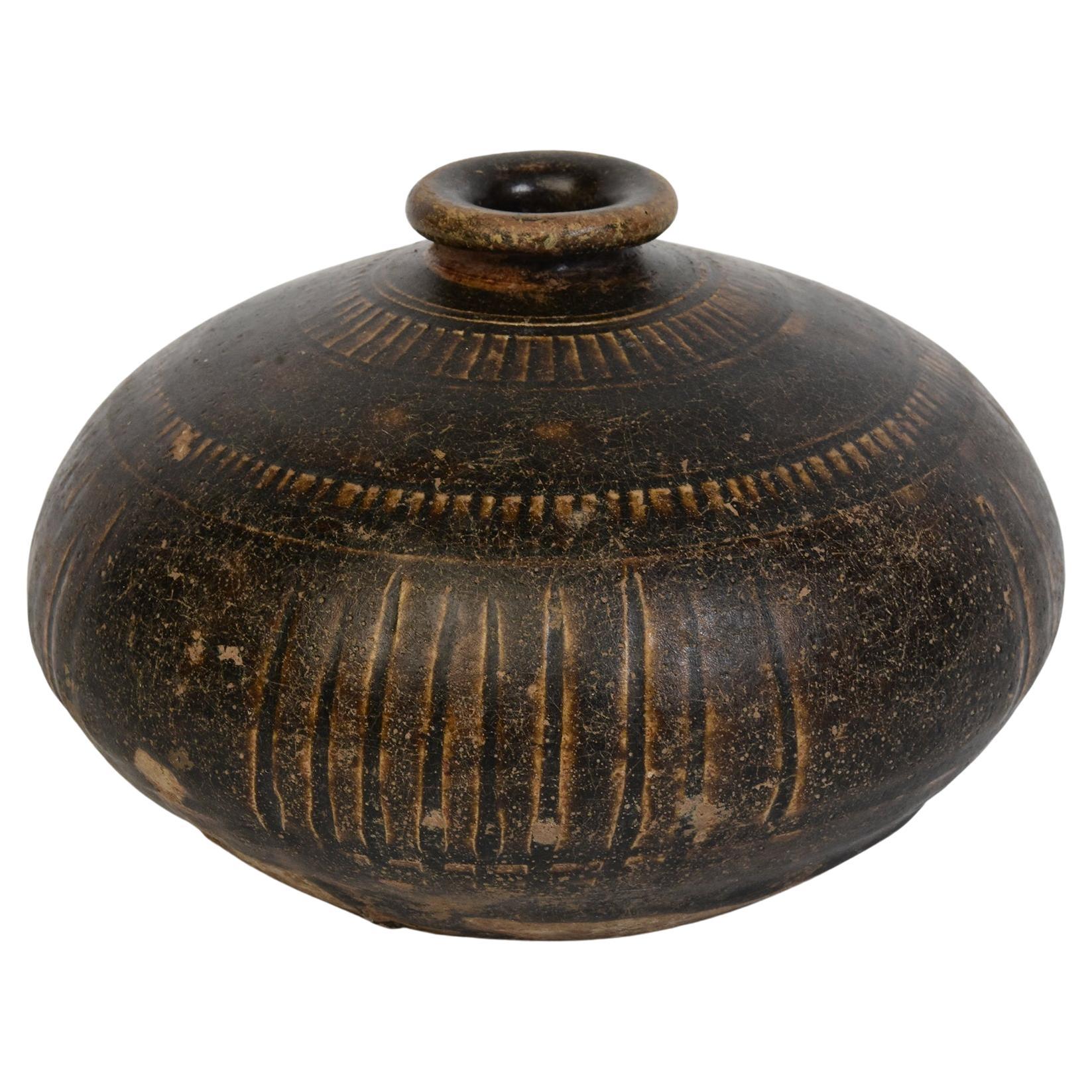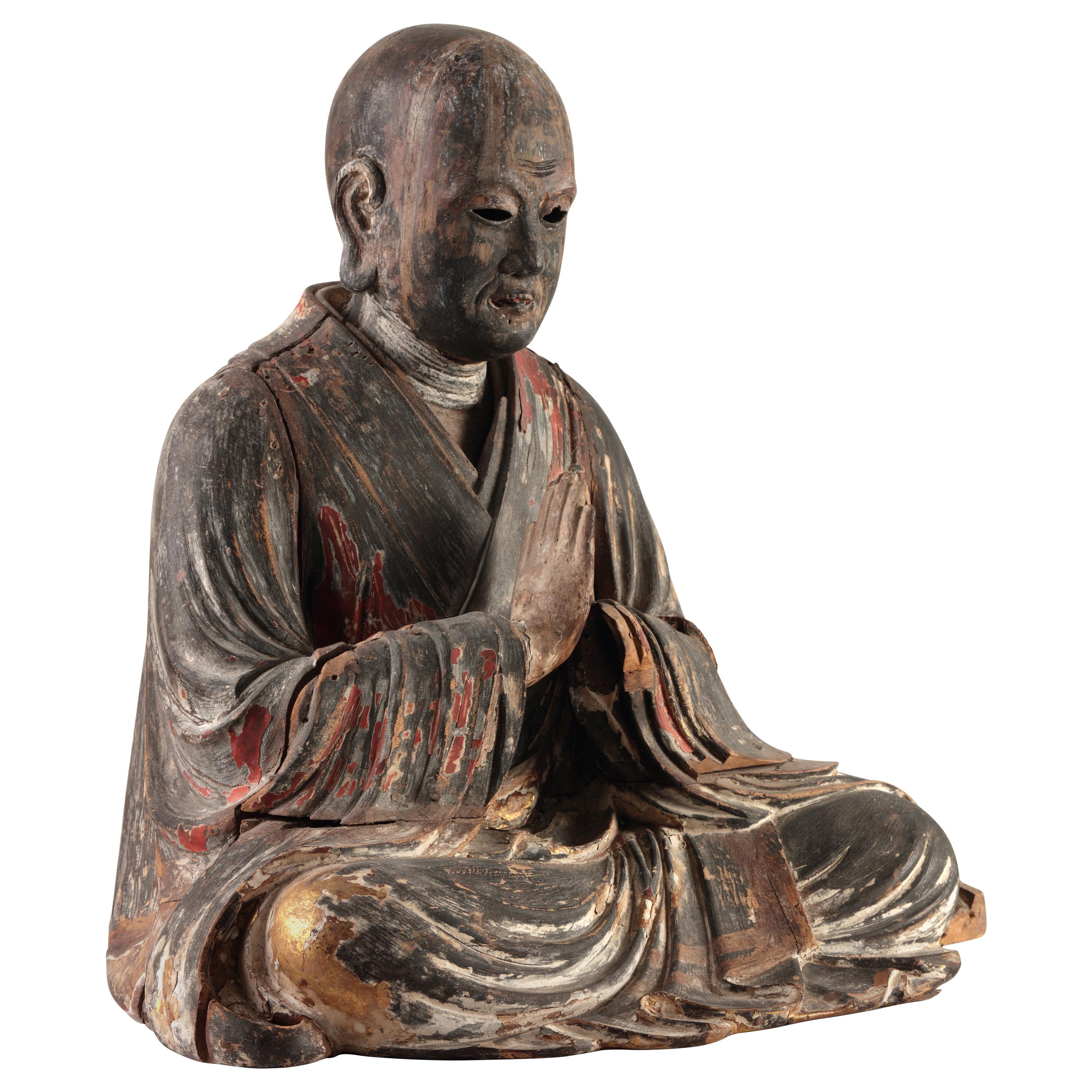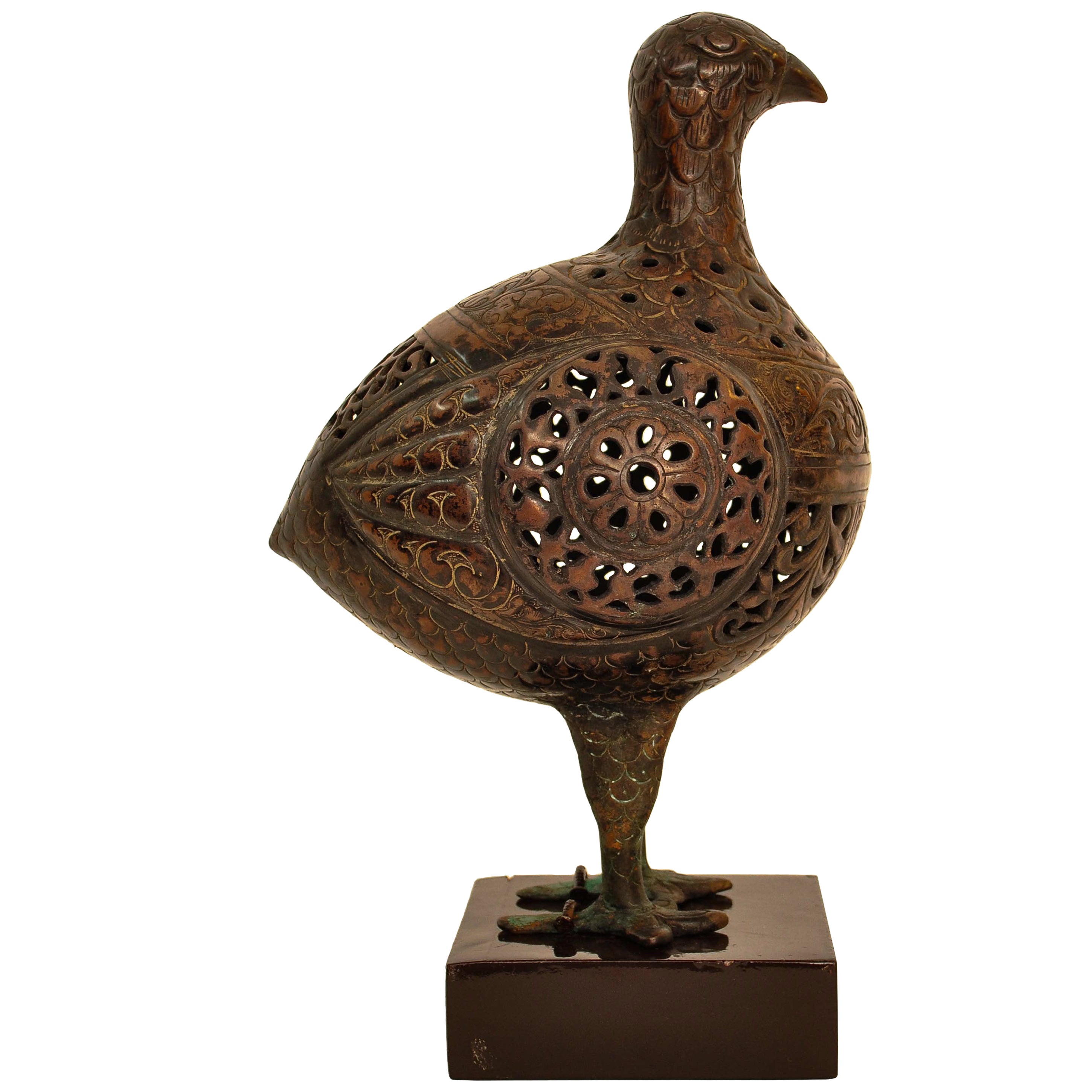Items Similar to Khmer Bronze Buddhist Triad, Style of the Bayon, 12th-13th Century, Cambodia
Want more images or videos?
Request additional images or videos from the seller
1 of 20
Khmer Bronze Buddhist Triad, Style of the Bayon, 12th-13th Century, Cambodia
About the Item
An important Khmer bronze Buddhist triad group featuring an image of the Buddha sheltered by a naga, and flanked by the bodhisattvas Avalokiteshvara and Prajnaparamita, Angkor Period, Style of the Bayon, late 12th-early 13th century, Cambodia.
This triad represents one of the most important images in Khmer art. The iconography was developed under the rule of King Jayavarman VII (ruled c. 1181 to c. 1218), with the imagery becoming the personal icon of the renowned king.
On the surface, this image represents the Buddha sheltered by the Naga King Muchalinda, the seven headed serpent, and flanked by two of the most important bodhisattvas in the Buddhist pantheon, Avalokiteshvara, the Bodhisattva of Compassion, and Prajnaparamita, the Bodhisattva of Transcendent Wisdom, also known as the Mother of All Buddhas.
On another level, this image is meant to represent the royal family in the guise of enlightened beings, with King Jayavarman VII as the Buddha, his father as Avalokiteshvara, and his mother as Prajnaparamita. This image further solidified the idea of the God King, or the divine right to rule. The crown upon the Buddha's head, and the rich jewelry that adorns him reinforces this ideology.
The image of the Buddha sheltered by a Naga, also known as Buddha Muchalinda, is an important image in Khmer art. Legend states that shortly after the Buddha reached enlightenment, he began a deep meditation. During his meditation, a large storm blew in. Fearing the Buddha's meditation would be interrupted by the malevolent storm, Muchalinda, King of the Nagas, raised the Buddha upon his coils and sheltered him with his seven hooded heads until the storm passed. The image conveys the protection Buddhist practitioners hope to obtain from the teachings of the Buddha.
Avalokiteshvara, the Bodhisattva of Compassion, is portrayed in his four armed form, representing his active nature. He is dressed in the regalia of royalty, with a crown upon his head, a large necklace, armlets and bracelets adorning his body. He wears a pleated sampot embellished with a jeweled belt. An image of Amitabha Buddha graces his crown.
Prajnaparamita, the Bodhisattva of Transcendent Wisdom, is portrayed as a matronly figure, bare chested, and adorned similarly to her counterpart, Avalokiteshvara, with a crown, and festooned with jewels. She holds a lotus bud in one hand, a sutra in the other.
The figures were cast separately then attached to the rectangular tiered plinth.
Provenance:
Dorris Weiner, 1980s
Dr. Charles Smithen Collection, 1990s.
- Dimensions:Height: 9 in (22.86 cm)Width: 7 in (17.78 cm)Depth: 1.5 in (3.81 cm)
- Materials and Techniques:Bronze,Cast
- Place of Origin:
- Period:
- Date of Manufacture:circa 1200
- Condition:Repaired: Repair of the top of the naga. The repair most noticeable at the back. One or two arms of Avalokiteshvara possibly repaired. Wear consistent with age and use. Minor structural damages. The top of the naga repaired. Small loss to the fishtail of the sampot. One or two arms of Avalokiteshvara possibly repaired. The bronze cleaned.
- Seller Location:Austin, TX
- Reference Number:1stDibs: LU894716285311
About the Seller
5.0
Gold Seller
These expertly vetted sellers are highly rated and consistently exceed customer expectations.
Established in 2001
1stDibs seller since 2010
303 sales on 1stDibs
Typical response time: 1 hour
- ShippingRetrieving quote...Ships From: Austin, TX
- Return PolicyA return for this item may be initiated within 7 days of delivery.
More From This SellerView All
- Khmer Bronze Uma, Angkor Wat Style, 12th Century, CambodiaLocated in Austin, TXA small Khmer bronze figure of the Hindu goddess Uma, Angkor Period, Style of Angkor Wat, circa 12th century, Cambodia. This small Khmer bronze devotiona...Category
Antique 15th Century and Earlier Cambodian Sculptures and Carvings
MaterialsBronze
- Lopburi Style Cast Bronze Figure of Uma, 13th-14th Century, ThailandLocated in Austin, TXA charming and unusual cast bronze figure of the Hindu goddess Uma, Lopburi Style, 13th-14th century, Thailand. Uma, the Hindu goddess of love and beauty, also known as Parvati, i...Category
Antique 15th Century and Earlier Thai Sculptures and Carvings
MaterialsBronze
- Korean Goryeo Bronze Bottle Vase with Green Patina, 12th/13th CenturyLocated in Austin, TXAn elegant and unusually large Korean Goryeo bronze bottle vase with green patina, Goryeo Dynasty, 12th/13th century, Korea. The graceful vase of typical bottle form, with a bulbous...Category
Antique 15th Century and Earlier Korean Antiquities
MaterialsBronze
- Khmer Cast Bronze Buddha Sheltered by Naga, 19th Century, CambodiaLocated in Austin, TXA well cast Khmer style bronze figure of an adorned Buddha sheltered by a Naga, Buddha Muchalinda, 19th century or earlier, Cambodia. The sculpture in th...Category
Antique 19th Century Cambodian Sculptures and Carvings
MaterialsBronze
- Thai Lopburi Cast Bronze Seated Buddha, 13th CenturyLocated in Austin, TXA fine early Thai Lopburi figure of a crowned and adorned Buddha, cast bronze, mid-13th century. The unusual figure of the Buddha sits in virasana upon a stylized lotus pedestal. He is dressed in the traditional monastic robes, but also adorned with a crown and jewelry, including earrings, a necklace, and jeweled belt. His hands in an atypical combination of mudras. His right hand in bhumisparsha mudra, reaching down to touch the earth, while his left hand held somewhat outwards, seemingly in varada mudra, the gesture of granting favours or wishes. The palm of his outstretched hand marked with the dharmachakra, the Wheel of the Law, representing Buddhist teaching. The bronze with a beautiful silvery patina. Lopburi was an independent Mon kingdom with strong ties to the Khmer Angkor...Category
Antique 15th Century and Earlier Thai Sculptures and Carvings
MaterialsBronze
- Gandharan Terracotta Figure of the Bodhisattva Maitreya, 4th-6th CenturyLocated in Austin, TXA very rare and decidedly charming half-scale terracotta sculpture of the bodhisattva Maitreya, the Buddha of the Future, ancient region of Gandha...Category
Antique 15th Century and Earlier Pakistani Sculptures and Carvings
MaterialsTerracotta
You May Also Like
- Ancient Polished Sandstone Lingam, Khmer, 12th-13th C., Angkor PeriodLocated in New York, NYAn Ancient Polished Sandstone lingam stone with an octagonal shaft which Rises from a Square Base, Khmer Period, 12-13th Century, Angkor Period. A fan...Category
Antique 15th Century and Earlier Cambodian Antiquities
MaterialsSandstone
- 12th - 13th Century, Bayon, Antique Khmer Dark-Brown Glazed Pottery Honey PotLocated in Sampantawong, THAntique Khmer dark-brown glazed pottery honey pot. Age: Cambodia, Bayon Period, 12th - 13th Century Size: Height 9 C.M. / Width 13.8 C.M. Conditi...Category
Antique 15th Century and Earlier Cambodian Antiquities
MaterialsPottery
- Japanese Kamakura/Muromachi Period Cedarwood Buddhist Priest, 12th-15th CenturyLocated in Amsterdam, NLSeated Buddhist priest Japan, Kamakura period (1185-1333) or Muromachi period (1333-1573). Different carved hollow blocks of cedar wood joined togeth...Category
Antique 15th Century and Earlier Japanese Sculptures and Carvings
MaterialsCedar
- Ancient Persia 12th Century Islamic Bronze Seljuk Bird Pomander Statue SculptureLocated in Portland, ORA fine and rare, ancient Islamic Seljuk period bronze bird statue, pomander, circa 1150, possibly Persia or Central Asia. The bird is finely modeled...Category
Antique 15th Century and Earlier Persian Islamic Antiquities
MaterialsBronze
- Antique Ceremonial Urns, Song Dynasty, 12th-13th CenturyLocated in New York, NYTwo tall ceremonial urns dating from the 12th-13th century, Southern Song dynasty. These two stunning vases depict 12 traditional ritual attendan...Category
Antique 15th Century and Earlier Chinese Other Antiquities
MaterialsCeladon
- 12th Century, Angkor Vat, Antique Khmer Bronze BowlLocated in Sampantawong, THAntique Khmer bronze bowl with nice patina. Age: Cambodia, Angkor Vat period, 12th Century Size: Diameter 11.4 C.M. / Height 6.3 C.M. Condition: Nice condition overall (some expecte...Category
Antique 15th Century and Earlier Cambodian Antiquities
MaterialsBronze
Recently Viewed
View AllMore Ways To Browse
13th Century
Buddhist Antique
Rectangular Carving
Buddhist Hand
Antique Buddhist Art
13th Century Furniture
12th Century Furniture
15th Century Bronze
Large Buddhist
Antique King Crown
Early 13th Century
15th Century Sculpture Head
Antique Asian Jewellery
Antique Asian Jewelry
Asian Antique Jewelry
Antique Buddha Head
Gold Festoon
Bronze Sculptures 1990s





